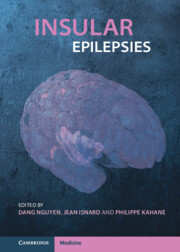Book contents
- Insular Epilepsies
- Insular Epilepsies
- Copyright page
- Contents
- Contributors
- Foreword
- Chapter 1 A Brief History of Insular Cortex Epilepsy
- Section 1 The Human Insula from an Epileptological Standpoint
- Section 2 The Spectrum of Epilepsies Involving the Insula
- Chapter 7 Clinical Presentation of Insulo-Opercular Epilepsy in Adults
- Chapter 8 Clinical Presentation of Insulo-Opercular Epilepsy in Children
- Chapter 9 Are Painful Seizures Specific to Insular Epilepsy?
- Chapter 10 The Role of the Insula in Temporal Lobe Epilepsy and Temporal Lobe “Plus” Epilepsies
- Chapter 11 Insular-Origin Seizures with a Hypermotor Presentation
- Chapter 12 The Role of the Insula in Sudden Unexpected Death in Epilepsy (SUDEP)
- Section 3 Noninvasive Investigation of Insular Epilepsy
- Section 4 Invasive Investigation of Insular Epilepsy
- Section 5 Surgical Management of Insular Epilepsy
- Index
- References
Chapter 10 - The Role of the Insula in Temporal Lobe Epilepsy and Temporal Lobe “Plus” Epilepsies
from Section 2 - The Spectrum of Epilepsies Involving the Insula
Published online by Cambridge University Press: 09 June 2022
- Insular Epilepsies
- Insular Epilepsies
- Copyright page
- Contents
- Contributors
- Foreword
- Chapter 1 A Brief History of Insular Cortex Epilepsy
- Section 1 The Human Insula from an Epileptological Standpoint
- Section 2 The Spectrum of Epilepsies Involving the Insula
- Chapter 7 Clinical Presentation of Insulo-Opercular Epilepsy in Adults
- Chapter 8 Clinical Presentation of Insulo-Opercular Epilepsy in Children
- Chapter 9 Are Painful Seizures Specific to Insular Epilepsy?
- Chapter 10 The Role of the Insula in Temporal Lobe Epilepsy and Temporal Lobe “Plus” Epilepsies
- Chapter 11 Insular-Origin Seizures with a Hypermotor Presentation
- Chapter 12 The Role of the Insula in Sudden Unexpected Death in Epilepsy (SUDEP)
- Section 3 Noninvasive Investigation of Insular Epilepsy
- Section 4 Invasive Investigation of Insular Epilepsy
- Section 5 Surgical Management of Insular Epilepsy
- Index
- References
Summary
The role of the insula in temporal and temporal plus epilepsies has been poorly investigated. The insula is buried deep within the lateral sulcus and has dense connections with neighbored regions, thus limiting the usefulness of available non-invasive diagnostic tools, such as scalp EEG, SPECT, and 18FDG-PET. Also, clinical features related to the involvement of the insula might be misleading, thus making it mandatory to use invasive EEG recordings in most cases. In fact, only a primary involvement of the insula in the epileptogenic network may require to include this area in the resection to achieve seizure freedom. Using modern neurosurgical techniques, insular epilepsy surgery has proved to be safe and beneficial in carefully investigated cases; however, its efficacy remains to be fully elucidated.
- Type
- Chapter
- Information
- Insular Epilepsies , pp. 110 - 117Publisher: Cambridge University PressPrint publication year: 2022

